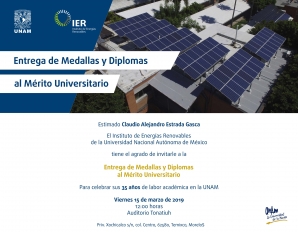Mostrando artículos por etiqueta: 2011 publication
Monte Carlo Heat Transfer Modeling of a Particle-Cloud Solar Reactor for SnO2Thermal Reduction
H.I. Villafán-Vidales,C.A. Arancibia-Bulnes, S. Abanades, D. Riveros-Rosas, H. Romero-Paredes
Abstract
A directly irradiated cavity solar reactor devoted to the thermal reduction of SnO2 particle-cloud is studied numerically by using the Monte Carlo method. The steady-state model solves the radiation and convection heat transfers in the semitransparent particle suspension and the chemical reaction. It was used to predict the temperature distribution and the reaction extent inside the cavity, as well as the theoretical thermochemical efficiency for different operational conditions. The simulations assume that the reactor contains a nonuniform size suspension of radiatively participating reacting SnO2 particles. The model takes into account the radiative characteristics of the particles, as well as the directional characteristics of the power distribution of the incoming concentrated solar energy. The particle concentration, the particle size, and the length of the reactor are varied. Results show that the particle temperature and the yield of the endothermic reaction are higher when the reactor is fed with a cloud of particles with average diameter of 20 μm. The maximal thermochemical efficiency reached is 10%, which corresponds to an optimal optical thickness of around 2.
Monte Carlo Heat Transfer Modeling of a Particle-Cloud Solar Reactor for SnO2Thermal Reduction
Influence of the Size of Facets on Point Focus Solar Concentrators
D. Riveros-Rosas, M. Sánchez-González, C. A. Arancibia-Bulnes, C. A. Estrada.
Abstract
It is a common practice in the development of point focus solar concentrators to use multiple identical reflecting facets, as a practical and economic alternative for the design and construction of large systems. This kind of systems behaves in a different manner than continuous paraboloidal concentrators. A theoretical study is carried out to understand the effect of the size of facets and of their optical errors in multiple facet point focus solar concentrating systems. For this purpose, a ray tracing program was developed based on the convolution technique, in which the brightness distribution of the sun and the optical errors of the reflecting surfaces are considered. The study shows that both the peak of concentration and the optimal focal distance of the system strongly depend on the size of the facets, and on their optical errors. These results are useful to help concentrator developers to have a better understanding of the relationship between manufacturing design restrictions and final optical behavior.
Influence of the Size of Facets on Point Focus Solar Concentrators

